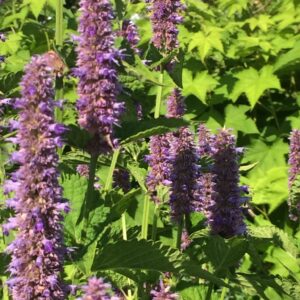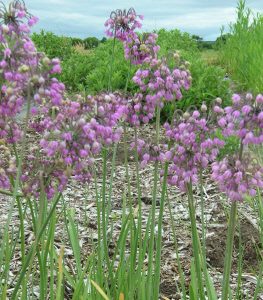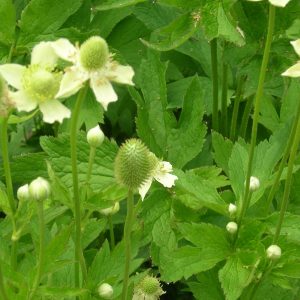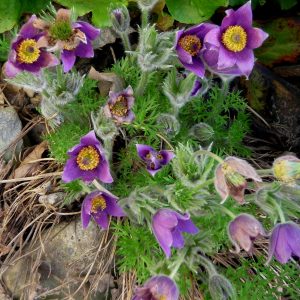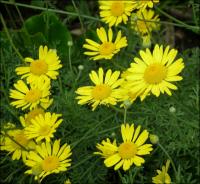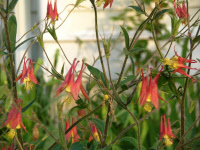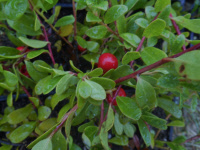Prairie Plants
Showing 1–8 of 81 results
-
Agastache foeniculum Anise hyssop Z 4-8
Purplish-blue spikes from July to October, very fragrant.
Purplish-blue spikes from July to October, very fragrant.
Size: 2-3' x 12"
Care: Full sun in well-drained soil, heat and drought tolerant.
Native: North America
Wildlife Value: Skipper butterflies and Rusty patched Bumble Bees love Anise hyssop’s nectar, Deer resistant.The name Agastache is from Greek agan and stachys meaning much like an ear of wheat referring to the shape of the flower spike. Anise hyssop leaves were used by American Americans of the Missouri River region to make tea and as a sweetener in cooking. For Cheyenne it relieved chest pain due to coughing or to a dispirited heart. Listed as an aromatic herb in Bernard McMahon’s 1805 book, American Gardener’s Calendar.
-
Allium cernuum Nodding onion, Prairie onion Z 4-8
Umbels of arching stems with nodding bells of lilac shading to pink or occasionally white. May to June.
Umbels of arching stems with nodding bells of lilac shading to pink or occasionally white. May to June.
We are very sorry, but due to state agricultural restrictions, we are not permitted to ship Allium bulbs to Idaho, or to the following five counties in the State of Washington: Adams, Benton, Franklin, Grant and Klickitat.
Size: 12”-18”x 3-6”
Care: sun to part shade in moist well-drained soil
Native: Canada to Mexico
Wildlife Value: nectar source for Hairstreak butterfly, Attracts hummingbirds. Alliums resist critters including deer, rabbits, squirrels, mice, and moles and voles. They cannot stand the onion-like smell of Alliums protecting near-by plants too.Cernuum is Latin meaning “nodding.” Many groups of 1st Americans ate the bulbs raw, roasted or dried for winter storage or as flavoring for soups and gravies. Cherokee used this plant medicinally to cure colds, hives, colic, “gravel & dropsy,” liver ailments, sore throats, “phthisic,” and feet in “nervous fever.” Those in the Isleta Pueblo were not quite as creative as the Cherokee and used this only for sore throats and infections. Meriwether Lewis collected this in Montana and wrote, “I met with great quantities of a small onion about the size of a musquit ball … They were crisp, white and well-flavoured. I gathered about a half a bushel of them before the crew arrivd.” Chicago is believed to be named for the Algonquin word for this plant chigagou.
-
Amorpha canescens Lead plant Z 2-9
Arching violet spikes flower in mid-summer top pinnately compound, grey-green leaves.
OUT OF STOCK
Arching violet spikes flower in mid-summer atop pinnately compound, grey-green leaves. Liberty Hyde Bailey (1933): “Handsome free-flowering shrub of dense habit, well adapted for rockeries and borders …”
ONLY AVAILABLE TO SHIP IN EARLY SPRING, WHILE DORMANT. (USUALLY APRIL/MAY)
Size: 2-3’ x 2-3’
Care: sun in well-drained to moist well-drained soil
Native: Broad swath of central No. America from Canada to TX. Wisconsin native. Common shrub in Great Plains’ tall-grass prairies and seasonally wet soil.
Wildlife Value: Honeybees and butterflies; especially Whitney's Underwing, relish its nectar. Supports over 50 bee species.
Awards: Great Plants for Great PlainsAmorpha means “deformed” in Greek and “becoming grey” in Latin. Called Lead plant due to old belief that plant grew in soil containing lead. Used medicinally by numerous Native Americans to kill pinworms, remedy eczema, stomach aches, neuralgia, rheumatism, and cuts. Steeped leaves made tea for Oglala. Oglala mixed its dried leaves with buffalo fat for smoking. Winnebago powdered the leaves, added water, and applied it to skin to remedy scalds. They also ate the roots. Sioux: A tea made from leaves drank as a beverage, treated flu related congestion and as a bath for eczema. Dried leaves part of mixture for smoking. Pre-bison hunt ceremony used stems. 1st described in published work in 1813.
-
Anemone cylindrica Thimbleweed Z 4-7
Each stem grows from a whorl of leaves. and then a single, white 5-petaled flower tops the stem. The flower turns into a green cylinder then transforms to cottony clouds.
Each stem grows from a whorl of leaves. and then a single, white 5-petaled flower tops the stem. The flower turns into a green cylinder then transforms to cottony clouds.
Size: 2’ x 12”
Care: full sun to part shade in well-drained soil.
Native: Maine to Delaware, British Columbia to Arizona and all parts in between. Wisconsin native
Wildlife Value: Leaves causing mouth irritation deters rabbit and deer. Pollinated by bees and flies.HoChunk and Winnebago put masticated fuzz from the seeds on boils or carbuncles, opening them after a day. Sioux used the root, a tap root, to treat burns, headaches and headaches. Collected for botany from the wild before 1880’s. Plant emits allelopathogin inhibiting seed germination of weeds.
-
Anemone vulgaris syn. Pulsatilla vulgaris Pasqueflower Z 4-8
Nodding, bell-shaped purple petals with yellow centers, flowers in early spring. Medusa-like seed heads.
Nodding, bell-shaped purple petals with yellow centers, flowers in early spring. Medusa-like seed heads.
Size: 8" x 8"
Care: sun in well-drained to moist well-drained soil
Native: Europe
Wildlife Value: Deer resistant, early pollen source for bees.
Awards: Great Plants for Great Plains, Royal Botanical Society Award of Garden MeritCultivated in Europe since at least medieval times. Possibly used by the Druids (about 2000 years ago) in their festival of the dawn goddess. Grown in the Eichstätt Garden, the garden of Johann Konrad von Gemmingen, prince bishop of Eichstätt in Bavaria, c. 1600. Jefferson planted this in 1771 in a shrubbery at Monticello. Called Pasque flower because it blooms at Easter time, well, maybe for gardens in Missouri or Maryland.
-
Anthemis tinctoria Marguerite
Cheerful yellow daisies all summer, non-stop.
Cheerful yellow daisies all summer, non-stop.
Size: 2-3' x 2'
Care: Full sun well-drained to moist well-drained soil, drought tolerant
Native: Eastern EuropeThis promiscuous flower sports maize colored daisies with ferny, aromatic foliage. The name Anthemis evolved from anthemon meaning “free flowering,” which describes the plant’s carefree, June through fall, blossoms. Philip Miller illustrated Marguerite in his 1750’s Dictionary. The flower was used to dye wool and to make tea.
-
Aquilegia canadensis Canada Columbine Z 3-9
In May and June yellow petticoats peek out from under eye-popping red skirts flaring at the ends as these flowers dangle from tall stems.
In May and June yellow petticoats peek out from under eye-popping red skirts flaring at the ends as these flowers dangle from tall stems.
Size: 24-36”x 12”
Care: part shade in moist well-drained soil - moist in spring & dry in summer
Native: Eastern Canada to Florida, west to New Mexico, Wisconsin native.
Wildlife Value: Provides rich, early spring nectar for bumblebees, bees, butterflies, and hummingbirds. Buntings and finches eat seeds. Sole food source for Columbine duskywing caterpillar.
Awards: England’s Royal Horticultural Society Award of Merit.Seeds are fragrant when crushed, used by Omaha, Ponca and Pawnee as perfume. Pawnee used the plant as a love charm by rubbing pulverized seeds in palm of hand and endeavoring to shake hand of desired person. Crushed seeds also used to cure fever and headaches. Cherokee made a tea for heart trouble. The Iroquois used the plant to cure poisoning and to detect people who were bewitched. Grown by Tradescant the Elder in England in 1632. He may have received it from France. Cultivated by Washington & Jefferson. Grown at America’s 1st botanic garden, Elgin Botanic Garden 1811.
-
Arctostaphylos uva-ursi Bearberry, Bear’s grape, Kinnikinnick Z 2-7
In spring fragrant, pinkish-white bell-shaped flowers, evergreen, glossy foliage and Marlboro red berries in fall.
OUT OF STOCK
“Dwarf ornamental shrub, ornamental in foliage, flowers and berry.” Rand 1866. In spring fragrant, pinkish-white bell-shaped flowers, evergreen, glossy foliage and Marlboro red berries in fall. Great for cascading over edge of wall or groundcover.
Size: 4” x 20” forms dense groundcover over time. Stems root to spread.
Care: sun to part shade in moist well-drained to dry, acidic soil. Needs watering until established. Best grown with protection from wind.
Native: No. America, Wisconsin native
Wildlife Value: Host for several butterfly species including Hoary Elfin, Brown Elfin and Freija Fritillary.
Awards: Cary Award Distinctive Plants for New EnglandKinnikinnick is Algonquin meaning “mixture.” Used as an ingredient in Native American smoke mixtures. For centuries leaves used to make medicinal tea as a tonic and diuretic in many parts of the world. Cheyenne drank the tea to cure back sprains. Some Native Americans used it to cure venereal disease, others to cure pimples and itching, peeling skin. Both Indians and colonists mixed leaves with tobacco for smoking. Collected by Meriwether Lewis on the Expedition.

